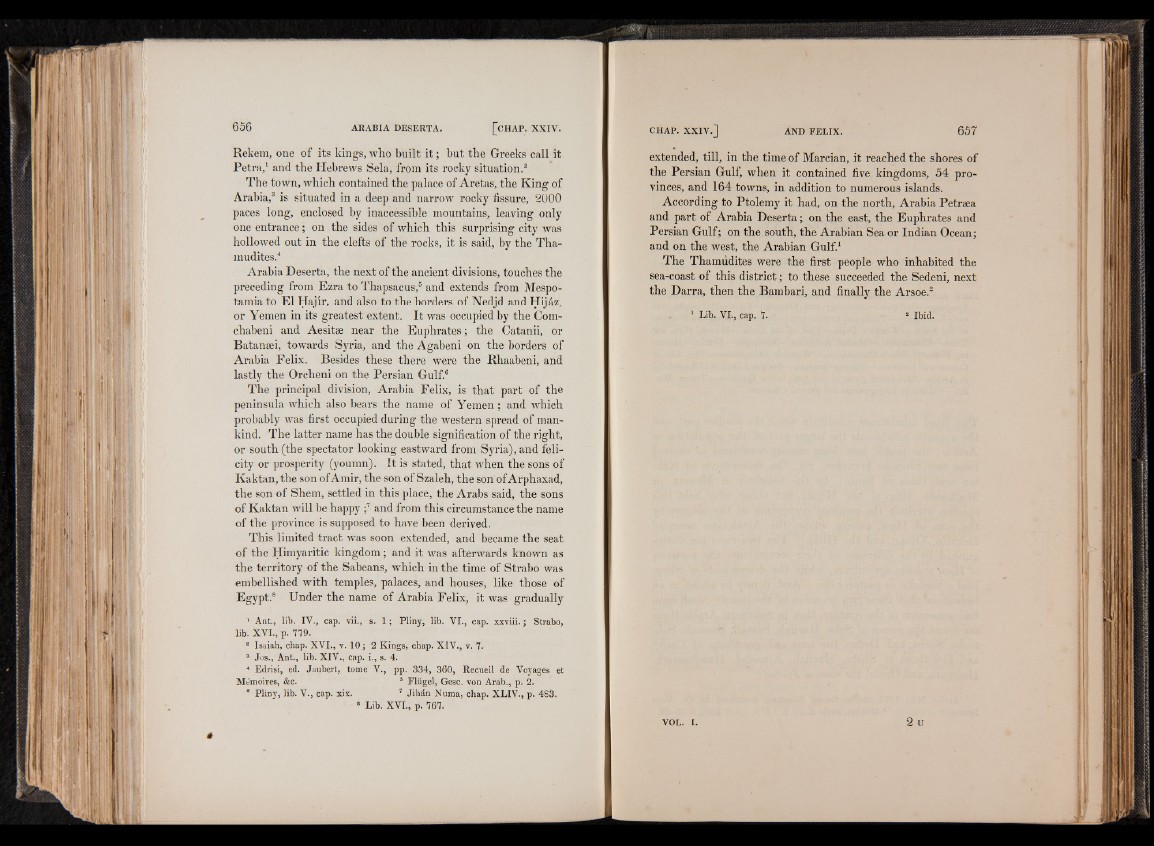
Rekem, one of its kings, who built it ; but the Greeks call it
Petra,1 and the Hebrews Sela, from its rocky situation.2
The town, which contained the palace of Aretas, the King of
Arabia,3 is situated in a deep and narrow rocky fissure, 2000
paces long, enclosed by inaccessible mountains, leaving only
one entrance ; on the sides of which this surprising city was
hollowed out in the clefts of the rocks, it is said, by the Tha-
mudites.4
Arabia Deserta, the next of the ancient divisions, touches the
preceding from Ezra to Thapsacus,5 and extends from Mespo-
tamia to El Hajir, and also to the borders of Nedjd and Hijáz,
or Yemen in its greatest extent. It was occupied by the Com-
chabeni and Aesitæ near the Euphrates ; the Catanii, or
Batanæi, towards Syria, and the Agabeni on the borders of
Arabia Felix. Besides these there were the Rhaabeni, and
lastly the Orcheni on the Persian Gulf.6
The principal division, Arabia Felix, is that part of the
peninsula which also bears the name of Yemen ; and which
probably was first occupied during the western spread of mankind.
The latter name has the double signification of the right,
or south (the spectator looking eastward from Syria), and felicity
or prosperity (youmn). It is stated, that when the sons of
Kaktan, the son of Amir, the son of Szaleh, the son of Arphaxad,
the son of Shem, settled in this place, the Arabs said, the sons
of Kaktan will be happy and from this circumstance the name
of the province is supposed to have been derived.
This limited tract was soon extended, and became the seat
of the Himyaritic kingdom ; and it was afterwards known as
the territory of the Sabeans, which in the time of Strabo was
embellished with temples, palaces, and houses, like those of
Egypt.8 Under the name of Arabia Felix, it was gradually
1 Ant., lib. IV., cap. vii., s. 1 ; Pliny, lib. VI., cap. xxviii. ; Strabo,
lib. XVI., p. TO.
8 Isaiah, chap. XVI., v. 10 ; 2 Kings, chap. XIV., v. 7.
3 Jos., Ant., lib. XIV., cap. i., s. 4.
4 Edrisi, ed. Jaubert, tome V., pp. 334, 360, Recueil de Voyages et
Mémoires, &c. 8 Flügel, Gesc. von Arab., p. 2.
’ Pliny, lib. V., cap. xix. 7 Jibán Numa, chap. XLIV., p. 483.
8 Lib. XVI., p. 767.
*
extended, till, in the time of Marcian, it reached the shores of
the Persian Gulf, when it contained five kingdoms, 54 provinces,
and 164 towns, in addition to numerous islands.
According to Ptolemy it had, on the north, Arabia Petraea
and part of Arabia Deserta; on the east, the Euphrates and
Persian Gulf; on the south, the Arabian Sea or Indian Ocean;
and on the west, the Arabian Gulf.1
.The Thamudites were the first people who inhabited the
sea-coast of this district; to these succeeded the Sedeni, next
the Darra, then the Bambari, and finally the Arsoe.2
- 1 Lib. VI., cap. 7. 8 Ibid.